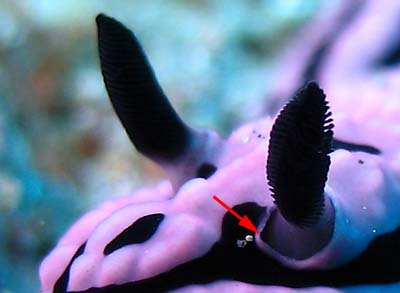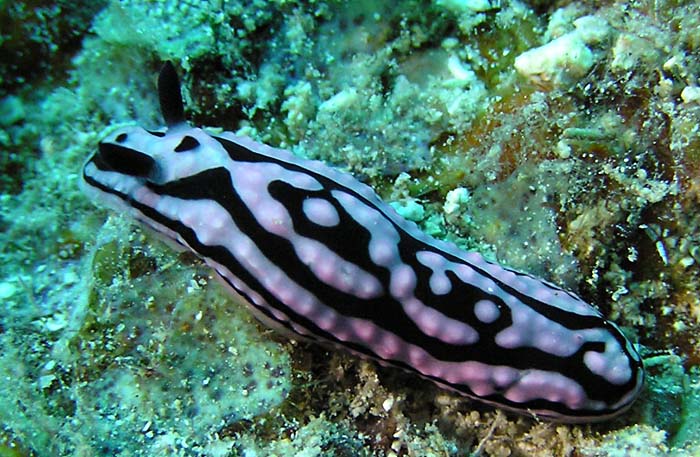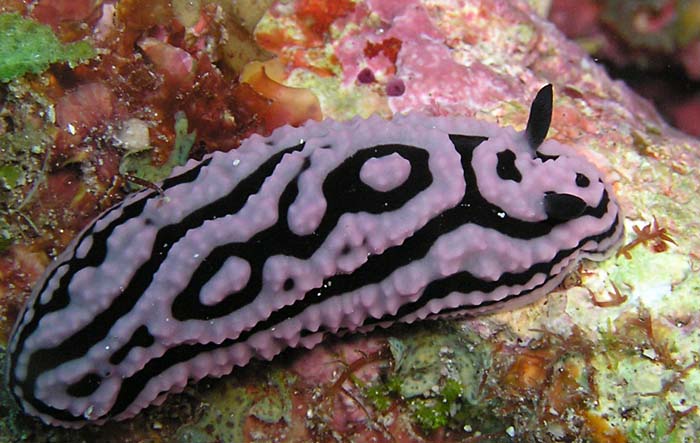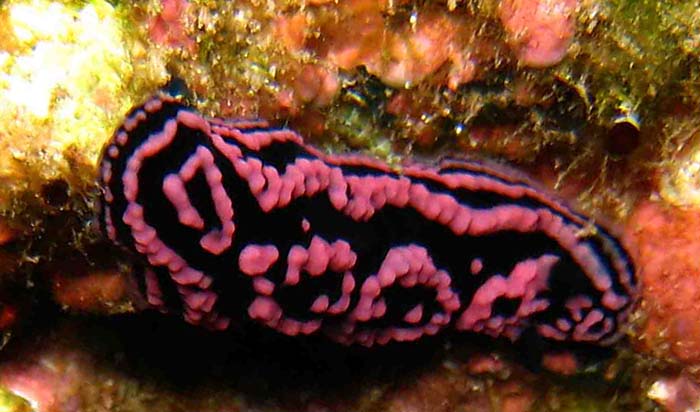This species has been observed on Reunion, Mauritius, Mayotte, Madagscar Islands
The rhinophores are black, the notum is black with pink to grey-blue tubercles There is a pink to grey-blue band around the mantle edge, and inside this band there are two tuberculate ridges which encircle the mantle, the outer one being quite narrow and the inner much broader. In the central part of the mantle there a characteristic pattern of pink to grey-blue rings (see below for entire description) |

|
|
Photo Florence Trentin Reunion, Saint-Leu. |
||
Remarks :
Identification confirmed by Bill Rudman
There is in our region a group of nudibranchs that I will call Phyllidiella meandrina/rosans/zeylanica difficult to identify, for two reasons: on the one hand the existence of many intermediate forms and on the other hand the very marked differences of opinion between specialists about these species ... I finally decided to make a classification (very questionable) of these specimens
- Group Phyllidiella rosans : There are 6-9 rounded, longitudinal pink ridges which are relatively smooth
- Group Phyllidiella cf. rosans : Up to nine rounded, longitudinal pink ridges which are relatively smooth with with surnumerous pink tubercules
- Group Phyllidiella meandrina : In the central part of the mantle there a characteristic pattern of pink to grey-blue rings
- Group Phyllidiella cf. meandrina : The disposition of the tubercles looks like P. meandrina but there are transverse black area beetween the tubercles all over the notum
- Group Phyllidiella zeylanica : In adult, up to nine longitudinal pink ridges (broken or interrupted) may occur and medially, presence of a more or less developed network of black band around the tubercles
Synonymous : (according Worms)
- Phyllidia meandrina Pruvot-Fol, 1957
Bibliographic data :
Other external morphology characteristics
In the central part of the mantle the arrangement of the pink to grey-blue tubercles is very characteristic.
At the anterior end there are two joined pink to grey-blue rings forming an irregular "figure 8" between the rhinophores, the ring behind the rhinophores is larger than the one on front.
Behind these rhinophoral rings is a large elongated ring, which has two isolated pink to grey-blue tubercles in the black central region.
Behind this ring is another elongated and irregular ring which apparently surrounds the anal papilla.
In some animals the ridges are quite sharply tuberculate while in others the tubercles are low giving the ridges a smooth appearance.
Another area of variation is the degree of isolation of the tubercles in the center of the rings. In some specimens they are isolated, while in other specimens they are connected to the surrounding ring by a short ridge.
The underside of the mantle and the foot are blackish grey
Similar species
Phyllidiella meandrina has similarities to Phyllidiella annulata in having a pattern of rings on the mantle but Phyllidiella annulata has a central row of 4 rings, an outer band of smaller rings, and no continuous pink to grey-blue edge to the mantle while Phyllidiella meandrina has a pink to grey-blue band and two tuberculate ridges around the mantle edge.
References :
Bill Rudman Seaslug site : Sea Slug Forum : Phyllidiella meandrina
Publications :
Brunckhorst, D.J.(1993) The systematics and phylogeny of Phyllidiid Nudibranchs (Doridoidea). Records of the Australian Museum, Supplement 16 : 1-107.
Fahrner, A. & Beck, L.A. (2000) Identification key to the Indo-Pacific species of the nudibranch family Phyllidiidae Rafinesque, 1814, including the description of two new species. Arch. Molluskenkd., 128 : 189-211.
Fahrner, A. & Schroedl, M. (2000) Redescription of Phyllidiopsis sinaiensis (Yonow, 1988) (Nudibranchia: Phyllidiidae), with a review of the Red Sea Phyllidiidae. J. Moll. Stud., 66 : 467-476.
Heller, J. & Thompson, T.E. (1983) Opisthobranch molluscs of the Sudanese Red Sea. Zoological Journal of the Linnean Society, 78(4) : 317-348.
Pruvot-Fol, A. (1957) Revision de la famille des Phyllidiadae. 2. Journal de Conchyliologie, 97 : 104-135, Pl.1.
Yonow, N. (1986) Red Sea Phyllidiidae (Mollusca: Nudibranchia) with descriptions of new species. Journal of Natural History, 20(6) : 1401-1428.
Yonow, N. & Hayward, P.J. (1991) Opisthobranches de l'Ile Maurice, avec la description de deux especes nouvelles (Mollusca: Opisthobranchia). Revue francaise d'aquariologie, 18(1) : 1-30, Figs 1-13.
Yonow, N., Anderson, R.C. & Buttress, S.G. (2002) Opisthobranch molluscs from the Chagos Archipelago, Central Indian Ocean. Journal of Natural History, 36(7) : 831-882
Yonow N. (2012) Opisthobranchs from the western Indian Ocean, with descriptions of two new species and ten new records (Mollusca, Gastropoda). ZooKeys 197: 1–129. [22 May 2012]
Other photos of Phyllidiella meandrina :
|
|
Florence Trentin Reunion, Saint Leu Strange black spots on the broader inner pink to grey-blue tuberculate ridge, and on the central area |
Emmanuel Eby Reunion, Saint Leu, 11 May 2004. In this specimen of Phyllidiella the tubercles in the center of the rings are connected to the surrounding ring by a short ridge. |
 |
|
|
Florence Trentin Reunion, Saint Leu, 01 August 2004 |
Delphine Dupin Reunion, Saint Leu, 04 May 2005. In this specimen of Phyllidiella we haven't the characteristic pattern in the central part of the mantle |
 |
In this specimen the rhinophore's sheath appears too large for the rhinophore... |
Hugues Flodrops Reunion, Eboulis Reef at Saint Leu, 15 m, 1 November 2006, size : 40 mm This specimen hasn't isolated pink to grey-blue tubercles in the two black central regions.  |
Matthias Deuss Mayotte, 23 December 2010
A specimen sharply tuberculate Not exactly the classical pattern, looks like some specimens of P. zeylanica... We have a lot of specimen like this!!! |
 |
|
|
Philippe Bourjon Reunion, La Saline lagoon, less 1 m, 13 May 2015 |
Sully Bachel Madagascar, Nosy bé, 12-14 m, 23 July 2010, size : 40 mm Not exactly the classical pattern, looks like some specimens of P. zeylanica... We have a lot of specimen like this!!! |
 |
|
|
Florence Trentin Reunion, Saint Leu, Les Arches, february 2005 A form with an abnormal pattern... |
Florence Trentin Reunion, Saint Leu,Maison verte, 7 October 2005, size : 25-30 mm A form with an abnormal pattern... |
|
|
|
Raphaël Roland Gosselin Reunion, Saint Leu, Le Mauselée, 5 March 2009
A very strange pattern |
More photos from Indian Ocean
Reunion Island, mating in P. meandrina, at Saint Leu, by Delphine Dupin
Mauritius Island, Phyllidiella meandrina, at Holt's Rocks, by Mathieu Bayon
Reunion, meeting between H. formosa and P. meandrina, at Saint Paul, by Guillaume Boeye
Mayotte, Phyllidiella meandrina with characteristic pattern, by Sylvain Le Bris






